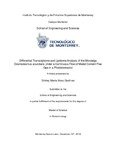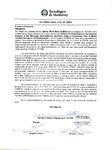| dc.contributor.advisor | Pacheco Moscoa, Adriana | |
| dc.contributor.advisor | Senés Guerrero, Carolina | |
| dc.creator | Mora Godínez, Shirley María | |
| dc.date.accessioned | 2019-03-15T21:46:09Z | |
| dc.date.available | 2019-03-15T21:46:09Z | |
| dc.date.created | 2018-12-14 | |
| dc.identifier.citation | Mora-Godínez, S. (2018). Differential Transcriptome and Lipidome Analysis of the Microalga Desmodesmus abundans Under a Continuous Flow of Model Cement Flue Gas in a Photobioreactor. Tecnológico de Monterrey, Monterrey, Nuevo León, México. | en_US |
| dc.identifier.uri | http://hdl.handle.net/11285/632974 | |
| dc.description.abstract | Microalgae represent a potential strategy for flue gas mitigation as they capture CO2 at high rates. Flue gases can also supply certain nutrients and, as a result, it can be valorized through biomass conversion into value-added compounds. The objective of this study was to characterize growth and analyze transcriptome, lipidome and cellular structure and composition of Desmodesmus abundans under continuous flow of cement model flue gas (MFG) in a 1 L photobioreactor using two strains adapted for nine years to atmospheres of 50% CO2 and air, referred to as HCA (high CO2 acclimated) and LCA (low CO2 acclimated), respectively. Controls with the LCA strain were also evaluated in air, CO2 and CO2+cement kiln dust (CKD). Higher initial growth rates were observed with strain HCA; however, at the end of the run (5 days) similar biomass productivity was reached by the two strains (0.30-0.34 g d.w. L-1 d-1). As expected, the CO2 control presented the highest growth rate (1.7-fold higher than under MFG), and when CKD was incorporated a slightly decreased (14 %) in growth was observed. Transcriptome analysis by RNA-seq, performed at day 4, resulted in a de novo assembly of 70 458 contigs with a N50 of 1 677 bp. Strain comparison under MFG resulted in 16 435 up-regulated and 4 219 down-regulated genes for strain HCA. Most of these genes were related with nucleotide, amino acid and carbon metabolisms; specifically, C3 and C4 cycle, glycolysis and gluconeogenesis, and TCA cycle, where almost all the contigs were up-regulated. In accordance, cell component GO terms up-regulated were in cell wall, chloroplast and photosystems. Likewise, starch and TAG metabolism were up-regulated. Cell structure analysis by SEM and TEM showed that most cells of both strains under MFG were unicellular contrary to typical Desmodesmus morphology; under air, some cells still preserved a grouping morphology. Strains cell size under MFG was similar (17-37 μm2), while under air cells were significant smaller (7-13 μm2). Both strains under MFG possessed high content of starch granules, a disorganized chloroplast and several lipid bodies, while a thicker cell wall was only observed in strain HCA. Biomass composition at the end of the run (day 5) showed no differences in proximate analysis between strains under MFG. A 1.8 to 2-fold higher protein content in strain LCA was found in complete medium (BG-11) than under MFG (BG-11-N-S). Under MFG, LCA presented the highest starch content (47.2 ± 22.3 % d.w) followed by HCA (23.1 ± 4.5 % d.w). On the contrary, HCA showed a higher content of pigments compared to LCA but the highest values were found in the control with only CO2. Lipidome analysis resulted in 663 detected features. Under MFG no many differences were found between strains by day 5; however, clear differences were observed at day 4 when both strains were in exponential growth. Particularly, 12 glycerolipids (GL) and 18 glycerophospholipids (GP) increased, and 27 GL and 3 GP decreased in HCA compared LCA. Still, most differences were found when strain LCA under MFG was compared with CO2+CKD (incomplete vs complete culture medium) that showed changes in GL (42 increased and 27 decreased) and GP (58 increased and 42 decreased), possibly attributed to low N in MFG. The results presented in this study show significant differences between strains HCA and LCA under MFG. However, most differences were observed at the transcriptome level (day 4), while biomass production was comparable at the end of the experimental period (day 5). Morphological changes appeared to be induced by the high CO2 condition at the moment of growth, with no significant differences between acclimated strains, except for a thicker cell wall in the HCA strain. Overall, both strains presented a high content of starch that represents a high value compound under MFG. Further studies could contemplate continuous cultures under MFG with longer experimental periods (>5 days) to validate differences between strains. Also, explore differences between strains at the genome level such as synonymous mutation rates by sequencing and studies of epigenetic changes. Additionally, metabolome and proteome analysis to better understand differences under the different control conditions. | en_US |
| dc.description.tableofcontents | Contents
Abstract v
List of Figures vi
List of Tables vii
1. Introduction 2
2. Theoretical Framework 5
2.1 Global warming 5
2.1 Cement industry 6
2.2 Microalgae 6
2.2.1 Photosynthesis 7
2.2.2 CO2 concentration mechanisms (CCM) 8
2.3 Bioremediation of flue gas using microalgae 9
2.4 Transcriptomics in microalgae 10
2.5 Lipid metabolism in microalgae 11
2.5.1 Fatty acids biosynthesis and catabolism 11
2.5.2 Triacylglycerols (TAGs) biosynthesis 12
2.6 Applications of microalgae biomass 13
3. Justification, hypothesis and objectives 15
3.1 Justification 15
3.2 Hypothesis 15
3.3 Objectives 15
3.3.1 General objective 15
3.3.2 Specific objectives 16
4. Study 1: Transcriptome analysis of the microalga Desmodesmus abundans under a continuous flow of model cement flue gas in a photobioreactor 18
4.1 Introduction 19
4.2 Methods 20
4.2.1 Microalga and culture conditions 20
4.2.2 Cement model flue gas (MFG) and cement kiln dust (CKD) 20
4.2.3 Microalga growth under model cement flue gas 21
4.2.4 Growth kinetics and specific growth rate 23
4.2.5 pH, dO2 and dCO2 analysis 24
4.2.6 Chemical analysis of NO₂−, NO3− and SO42- in solution 24
4.2.7 Determination of CO2, NO and SO2 assimilation 24
4.2.8 Statistical analysis 25
4.2.9 RNA extraction 25
4.2.10 RNA-seq library construction 26
4.2.11 Transcriptome de novo assembly and functional annotations 26
4.2.12 Differential expression analysis 27
4.3 Results 28
4.3.1 Microalga growth under MFG and CO2 utilization efficiency 28
4.3.2 NOx and SOx assimilation 30
4.3.3 de novo transcriptome assembly and functional annotation 31
4.3.4 Differentially expressed genes under continuous cement flue gas and nine years of strain enrichment under 50% CO2 and air atmospheres 32
4.3.5 Differentially expressed genes of D. abundans strain LCA with different components of the model cement flue gas 35
4.4 Discussion 36
4.4.1 Microalga growth under cement model flue gas 36
4.4.2 de novo transcriptome assembly and functional annotations 39
4.4.3 Differentially expressed genes under continuous cement flue gas and nine years of strain enriched in 50% CO2 and air atmospheres 39
4.4.4 Differentially expressed genes of D. abundans strain LCA with different components of the model cement flue gas 43
4.5 Conclusions 44
Tables and figures 46
5. Study 2: Biomass composition and lipidome analysis of the microalga Desmodesmus abundans under a continuous flow of model cement flue gas in a photobioreactor 72
5.1 Introduction 73
5.2 Materials and methods 74
5.2.1 Microalga and culture conditions 74
5.2.2 Microalga growth under model cement flue gas 75
5.2.3 Scanning electron microscopy (SEM) and transmission electron microscopy (TEM) 76
5.2.4 Proximate analysis of microalgae biomass 77
5.2.5 Starch content determination 77
5.2.1 Pigment content determination 77
5.2.2 Statistical analysis 78
5.2.3 Lipidome analysis 78
5.3 Results 80
5.3.1 Cell morphology and structure 80
5.3.2 Biomass composition 81
5.3.3 Starch content 82
5.3.4 Chlorophyll and carotenoid content 82
5.3.5 Lipidome changes of D. abundans under model cement flue gas 82
5.4 Discussion 84
5.4.1 Morphological and structural changes 84
5.4.2 Biomass composition 85
5.4.1 Lipidome changes of D. abundans under model cement flue gas 88
5.5 Conclusions 91
Tables and figures 92
6. Conclusions 105
6.1 Further studies 106
Appendix A 108
6.2 Theoretical dissolved gases 108
Appendix B 110
6.3 RNA quality and quantification 110
6.4 RNA-seq library construction 111
6.5 Sequencing results 114
Appendix C 116
6.6 de novo assembly and functional annotations 116
Bibliography 118
Curriculum Vitae 130
| en_US |
| dc.format.extent | 149 | en_US |
| dc.language.iso | eng | en_US |
| dc.publisher | Instituto Tecnológico y de Estudios Superiores de Monterrey | esp |
| dc.relation.ispartof | N/A | en_US |
| dc.rights | Open Access | en_US |
| dc.subject | 2 BIOLOGÍA Y QUÍMICA | en_US |
| dc.title | Differential Transcriptome and Lipidome Analysis of the Microalga Desmodesmus abundans Under a Continuous Flow of Model Cement Flue Gas in a Photobioreactor | en_US |
| dc.type | Tesis de Maestría / master Thesis | en_US |
| dc.publisher.institution | Instituto Tecnológico y de Estudios Superiores de Monterrey | en_US |
| dc.subject.keyword | Microalgae, Desmodesmus, flue gas, cement kiln dust, transcriptome, biomass composition, lipidome, cell morphology | en_US |
| dc.subject.discipline | Ingeniería y Ciencias Aplicadas / Engineering & Applied Sciences | en_US |
| dc.description.degree | Maestría en Ciencia con Especialidad en Biotecnología | en_US |
| dc.audience.educationlevel | Grupos comunitarios/Community Groups | en_US |
| refterms.dateFOA | 2019-03-15T21:46:10Z | |
| dc.relation.impreso | 2018-12-14 | |

